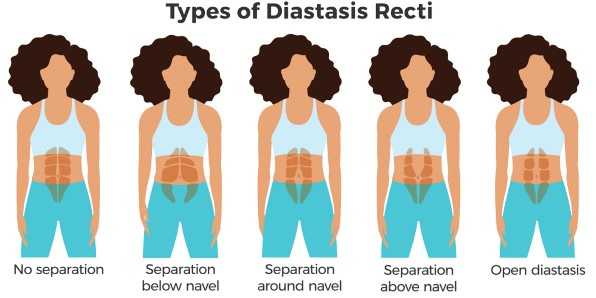Diastasis recti, or separation of the abdominal muscles, is a common side effect of pregnancy, yet many expectant and new moms don’t even know what it is, let alone whether or not they have it.

The rectus abdominis muscle is the vertically-oriented “six pack” muscle that is susceptible to splitting open when the uterus grows upward out of the pelvis. The two sides of the muscle are held together by a fibrous connective tissue. The strain on the muscle can cause that tissue to open like a zipper above and below the belly button. It sounds terrible, but the separation itself is surprisingly painless because the connective tissue has no nerve supply. What you will feel, though, is an achy low back after the muscles start to open. Why? Because the muscles lose their mechanical advantage once they separate, so they become weak and no longer protect the low back.
Wondering how the abdominal muscles, on the front of the body, protect the lower back? All the abs muscles work together as a team, acting as a corset to support the lumbar spine. A large part of the stability in the lumbar spine comes from that abdominal muscle corset. So when a major player on that team is injured, it can’t perform, and you lose function.
What does this mean for you?
The symptoms of this condition can vary from woman to woman, so it’s important to understand what to look for if you’re pregnant or if you have recently given birth. The most obvious symptom is a postpartum pooch around your ab muscles. However, that doesn’t always mean you have diastasis recti. It could indicate a weak transverse abdominis or weak core. You might also think you have diastasis if your belly has a “bread loaf” or ridge or it cones as you roll to sit up.
The following are also symptoms of diastasis recti:
- Weakening of pelvic floor muscles
- Pelvic floor dysfunction
- Incontinence
- Pelvic pain
- Lower back pain
- Pain during intercourse
- Poor posture
- Umbilical hernia
- Inability to activate core muscles
- Repeated C-sections – During the procedure, the recti muscles are moved. During healing the scar tissue can cause adhesions to the abdominals, pelvic floor and surrounding muscles.
What can you do?
First off, test yourself to see if you already have a separation. If you do, you must modify activities during pregnancy to avoid increasing the separation.
The test: Lying on your back with knees bent and feet flat, place your fingers on your tummy an inch above your navel, pointing toward your knees. Press your low back flat, then tuck your chin to lift your head and shoulders off the floor. You should feel the two sides of the rectus abdominis muscle with your fingers. If you can get fewer than three fingers into the gap side-to-side, the separation is considered within normal range.
How to Improve Diastasis Recti
It’s possible to improve diastasis recti by repairing and strengthening your deep core muscles through a variety of abdominal exercises specifically targeting your transverse abdominis. Your rectus abdominis run along your abdomen in two parallel bands. These muscle bands are connected by a bit of connective tissue in the middle called the linea alba. Underneath lies the obliques and transverse abdominis. The transverse abodminis runs horizontal. Because these muscle fibers run horizontal, exercises dedicated to the transverse abdominis help approximate the rectus abdominis, which help to minimize the gap.
In your exercise, it’s important to avoid increasing pressure on your belly tissues, at least until you’ve created core stability. It is best to avoid the following motions:
- Twisting your trunk
- Traditional core exercises (such as crunches and sit ups)
- Heavy lifting
- Non-modified push-ups
Prenatal and Postnatal Personal Training is not a one size fits all program, every woman is unique. That is why I take so much pride in my specialized programming. My goal is to provide you with the coaching, guidance, education (including Diastasis Recti) and motivation you need to tackle you and your baby’s health through fitness. I offer in studio training as well as online coaching if you are not in the San Diego area. As always consult with your doctor before starting any exercise plan.

Ready to Reclaim Your Personal Power?
Allow yourself to receive the most effective form of training with personal training, or our online fitness & macro coaching.


 9 Tips to Get Past a Weight Loss Plateau
9 Tips to Get Past a Weight Loss Plateau
